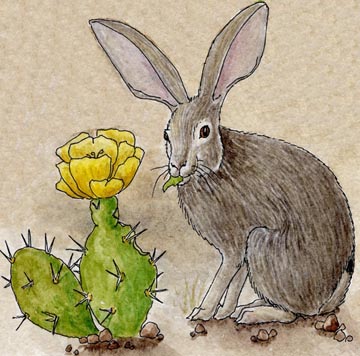


They are found in the western U.S. from the west coast east to Nebraska and Texas.
They live in grassy fields, prairies, desert scrubland and farmland.
They are grayish-brown. They are about 2 feet long with long ears that have black tips. They have large feet and very long legs and jump 20 feet. They weigh up to 4 pounds. Females are larger. The black-tailed jackrabbit is really a hare. Rabbits are born helpless and bald, while hares are born with fur and their eyes open.
They rest during the day hidden in the shade and are active late in day and at night. They can run up to 30 miles an hour, often in a zigzag pattern to escape predators.
They eat grasses and woody plants and shrubs, like; creosote bushes, mesquite trees, snakeweeds, junipers, big sagebrushes, and cacti. They can survive a long time without water, getting what they need from the plants they eat.
They are eaten by hawks, coyotes, foxes, bobcats, badgers and weasels.
Females are pregnant for 45 days (gestation) having 3-4 young. They can have up to 4 litters a year. Females make a nest of by digging a dent in the ground in a hidden place and lining it with her own fur. Babies only nurse for a few days before they become independent.
They live at most 5-6 years in the wild, usually much shorter. They are listed as Lower Risk - least concern.
Kingdom: Animalia
Phylum: Chordata
Subphylum: Vertebrata
Class: Mammalia
Order: Lagomorpha
Family: Leporidae
Genus: Lepus
Species: Lepus californicus
When you research information you must cite the reference. Citing for websites is different from citing from books, magazines and periodicals. The style of citing shown here is from the MLA Style Citations (Modern Language Association).
When citing a WEBSITE the general format is as follows.
Author Last Name, First Name(s). "Title: Subtitle of Part of Web Page, if appropriate." Title: Subtitle: Section of Page if appropriate. Sponsoring/Publishing Agency, If Given. Additional significant descriptive information. Date of Electronic Publication or other Date, such as Last Updated. Day Month Year of access < URL >.
Amsel, Sheri. "Jackrabbit (Black-tailed)" Exploring Nature Educational Resource ©2005-2024. December 13, 2024
< http://www.exploringnature.org/db/view/Jackrabbit-Black-tailed >
